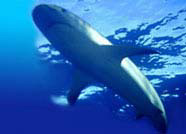


Shark Glossary

 |
 |
 |
|||
| Home | Evolution
| Classification
| Glossary | Biology
| Behavior | Shark
Repellent | Shark
Conservation | Do's &
Don'ts | Did You Know?
Shark Glossary |
 |
||||
|
 Nares NaresThe nares are the nasal openings of an animal, or the nostrils. Shark nostrils are used only for the sense of smell, not for respiration. Nasal Barbel Nasal barbels are sensory projections near the nostrils and mouth of some sharks (e.g., the nurse shark). These barbels are whisker-like feelers used to taste and feel. Nicaragua Shark Carcharhinus leucas is also known as the Bull shark, the Ganges shark, the River shark, the Cub shark, the Zambezi shark, the Shovelnose shark, the Slipway gray shark, the Squ  are-nose
shark, and Van Rooyen's shark. It is a large, fierce predator that eats
fish, including other sharks, ray, and just about anything else. It has
been known to attack people and will venture into fresh water are-nose
shark, and Van Rooyen's shark. It is a large, fierce predator that eats
fish, including other sharks, ray, and just about anything else. It has
been known to attack people and will venture into fresh waterNictitating Membrane Some sharks (Carcharhiniformes) have a nictitating membrane, a type of eyelid that protects the eye during hunting. Northern Whaler Shark  Carcharhinus plumbeus (also called the sandbar shark, brown shark, the thickskin shark, and the ground shark) is a common shark with a very tall dorsal fin. They have mouse-gray skin, with paler skin below; the head is wide and flat. They largest found was about 8 ft (2.4 m) long; on average, females are 6 ft (1.8 m) long and males are 3.2 ft (1 m) long. Sandbar sharks are found from very shallow waters to deep waters, generally staying on the bottom. They also frequent estuaries and harbors. Sandbar sharks have a growth rate of about 1.7 inches (43 mm) per year, a slow growth rate for sharks. The thick skin is used for leather. These strong swimmers migrate over 1550 miles (2500 km). Their diet is mostly fish, including menhaden, eels, other sharks, skates, squid, and also crustaceans. Females are mature at 16 years and give birth to 8-12 live young after a gestation period of 9-12 months. Pups are about 8.5 inches (22 cm) long at birth. Classification: Order Carcharhiniformes, Family Carcharhinidae (requiem sharks). Nostrils Sharks and rays have paired nostrils on the underside of the snout. Water continually flows through the nostrils, giving the shark olfactory (the sense of smell) information. Unlike humans, shark nostrils have nothing to do with breathing - they are not even connected to the mouth.  Nurse
Sharks Nurse
Sharks Ginglymostoma cirratum is a large, sluggish shark that is generally harmless unless provoked. It has very strong jaws, a stout body, and a wide head. They are dark gray on top, some with spots. They are nocturnal hunters that rest during the day in groups. Nurse sharks do well in captivity. |
|
||||||||||||
| Sitemap | Reach To Us | Jimtrade - Business Directory of India | |||||||||||||